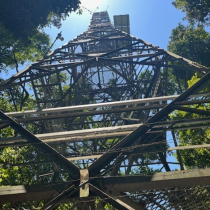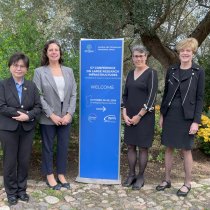Attending SACNAS: An Inspiring Experience
November 21, 2014
By Liz Goehring
According to the Merriam-Webster dictionary, inspiration is “something that makes one want to do something, or that gives one an idea about what to do or create.” For me, inspiration also renews my sense of purpose. SACNAS (Society for the Advancement of Hispanic/Chicano and Native Americans in Science) is all about inspiration, and that is why it was such a pleasure to attend the national conference last month in Los Angeles. I’ve attended many scientific conferences over the years, but I have never experienced one so focused on student involvement and career preparation, and so filled with inspiring people.
I work in science education and one of the biggest issues in my field is the significant shortage of STEM (Science, Technology, Engineering and Mathematics) workers in this country, and the even greater shortage from certain U.S. demographics. Without a scientifically and technically trained future workforce, we will struggle to solve the challenges facing our world today. Many factors lead to this shortage but clearly one is that, as a nation, we are not attracting enough talented youth into STEM programs. It’s a rigorous path to become a research scientist, or a physician, or an engineer – and it requires a good bit of guidance, opportunity and perseverance along the way. But it also requires vision. I’m happy to report that SACNAS is helping show the way to many talented youth who otherwise might not have seen themselves in a STEM career or known how to get there.
Liz Goehring explaining the benefits of NEON's undergraduate internship program to Paul Awo, from Kapi'olani Community College, Hawaii at SACNAS (Society for the Advancement of Hispanic/Chicano and Native Americans in Science) conference.
So what is it that’s so special about SACNAS? For several years colleagues have advised me to connect with SACNAS to find meaningful ways of increasing participation of underrepresented groups in science and engineering. Never having attended a SACNAS conference, I didn’t understand what was unique about this society. Well, this year I got to experience SACNAS first hand. I met “SACNISTAs” – i.e., students, faculty, scientists, and engineers from community colleges, tribal colleges, universities, research institutions, medical institutions, and businesses – in other words, STEM professionals from all walks of life. I read excellent student posters showcasing their research. At our booth in the Exhibit Hall, I talked with well-prepared students eager to learn about opportunities at NEON. In the plenary sessions, I listened to inspiring presentations from leading scientists, many of whom told stories of growing up in supportive families but without the means or experience base to navigate college life, and yet they did. And again and again, I heard folks give thanks to the mentors who helped guide them along their individual paths, mentors who continued to believe in and encourage students until they made it on their own. All of this organized by a society dedicated to helping launch students into STEM careers.
SACNAS students hear inspiring talks during plenary sessions each day
One mentor who received a SACNAS award has helped over 2500 students enter STEM careers over his tenure managing a biology scholars program!! Wow.
SACNAS and NEON share a common goal: to help prepare future STEM professionals, especially those from underrepresented groups in science and engineering. Choosing and preparing for a STEM career is a journey. Many factors shape and guide that journey, including early exposure to STEM careers and role models, encouragement from parents, teachers and guidance counselors, access to quality education, and opportunities to test out one’s knowledge and abilities in real-world situations. SACNAS clearly plays a huge role in this journey. I’m excited that NEON can play a role too—through our internship program—by providing challenging real-world science and engineering projects; dedicated mentors; logistical support in the form of housing, travel, and stipends; and professional networking opportunities galore. Internships give students the opportunity to try out career options and develop skillsets that will serve them well in their professional lives. Internships can help sharpen the student’s vision of their future.
Sofia Toro from the Keck Graduate Institute gathers information on internships for students at the Claremont Colleges.
Flying home from the conference, I found myself thinking about the future and about next summer’s cohort of students. NEON’s undergraduate internship program has two successful years under its belt, in huge part thanks to the wonderful students with whom we’ve had the pleasure to work (see their projects and bios). Every year is a bit different and this year I’m looking forward to seeing new faces from new communities. Which of these bright students will join us in our mission to build a national ecological observatory to monitor our ecosystems over the next 30 years? What will they learn in the process and what will they teach us along the way?
Find out more about NEON’s undergraduate internship program and how to apply here.


